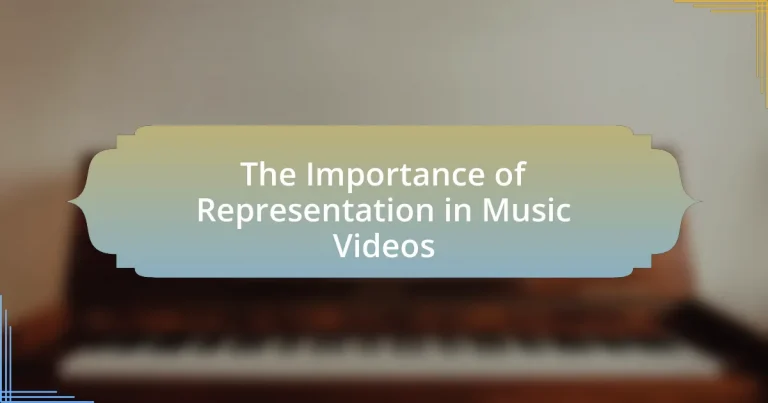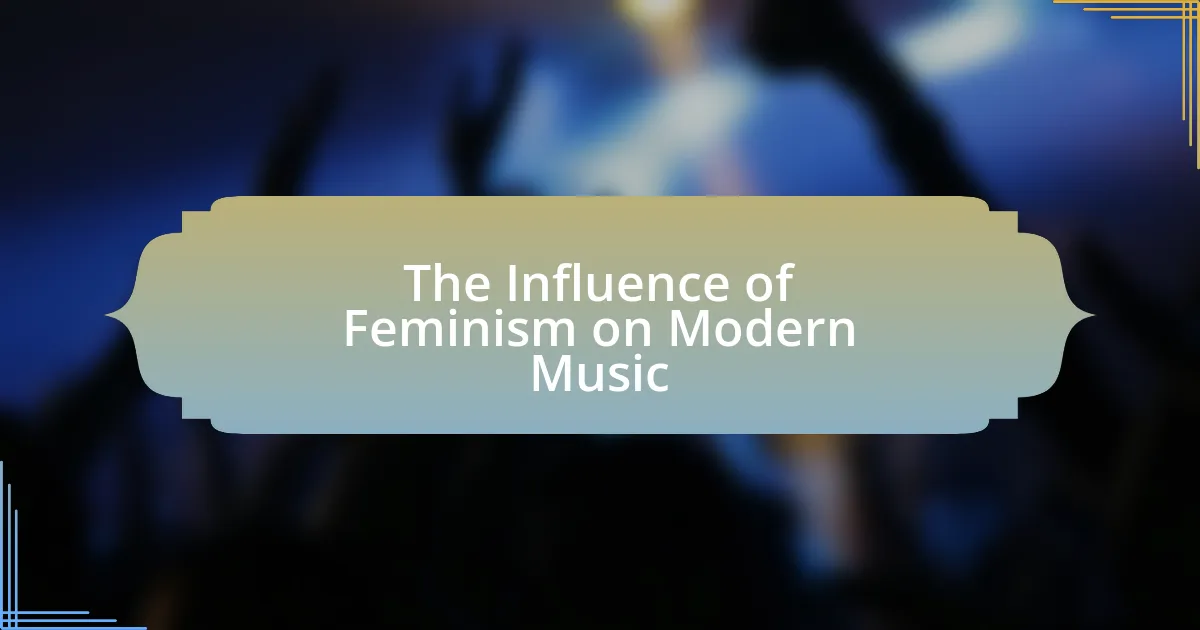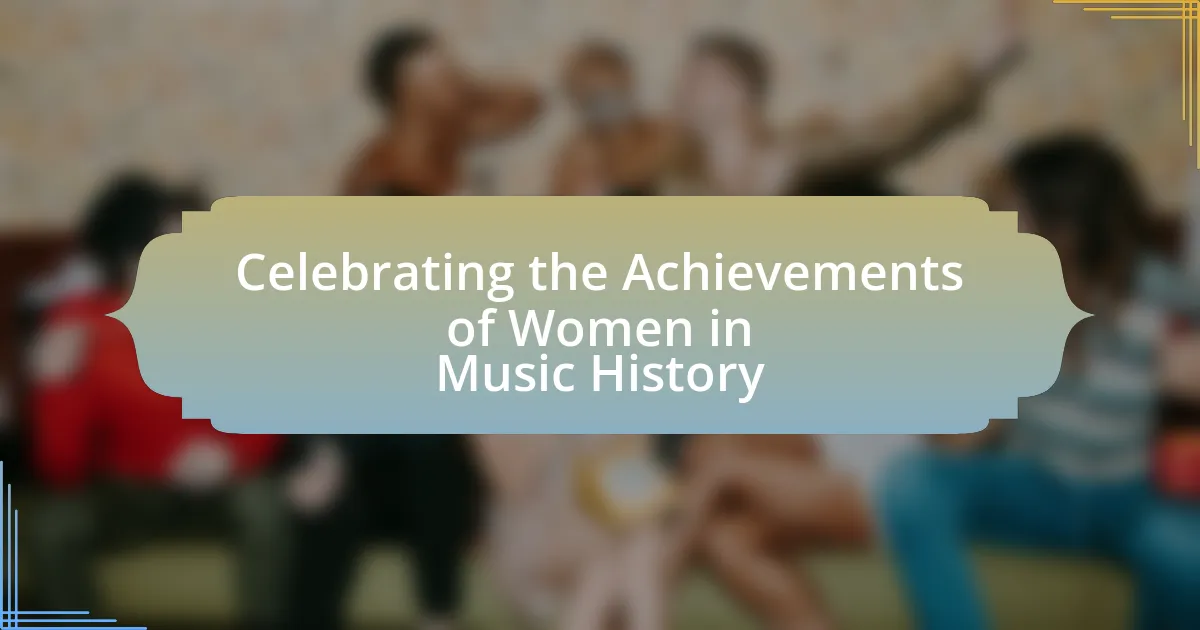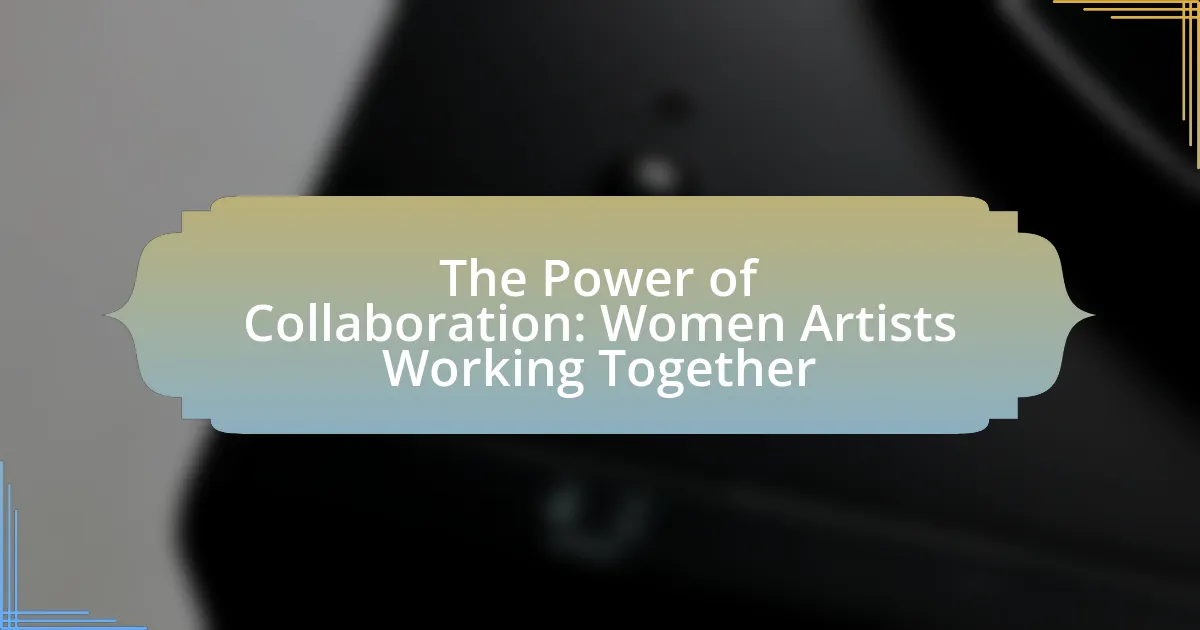The article focuses on the importance of representation in music videos, emphasizing its role in shaping cultural narratives and influencing societal perceptions. It discusses how diverse representation impacts self-esteem, social acceptance, and audience engagement, highlighting the positive correlation between visibility of marginalized groups and societal attitudes. The article also explores the historical evolution of representation in music videos, the intersection of representation with social issues, and the consequences of inadequate representation. Additionally, it outlines best practices for promoting positive representation and the potential benefits of improved inclusivity in the music industry.
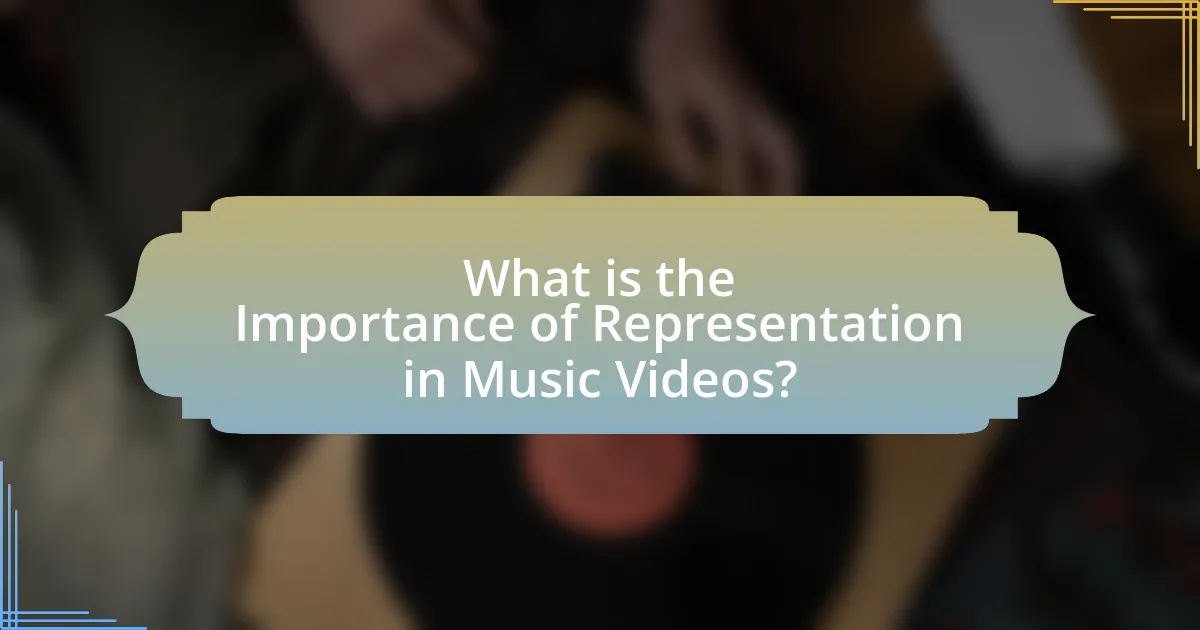
What is the Importance of Representation in Music Videos?
Representation in music videos is crucial as it shapes cultural narratives and influences societal perceptions. Music videos serve as a visual medium that reflects and constructs identities, allowing diverse groups to see themselves represented in mainstream media. Studies show that representation can impact self-esteem and social acceptance; for instance, a 2019 report by the Geena Davis Institute on Gender in Media found that increased visibility of women and minorities in media correlates with positive societal attitudes towards these groups. Thus, representation in music videos not only fosters inclusivity but also drives social change by challenging stereotypes and promoting understanding among different communities.
Why is representation significant in the context of music videos?
Representation is significant in the context of music videos because it shapes cultural narratives and influences audience perceptions. Music videos serve as a visual medium that reflects societal values, identities, and experiences, allowing diverse groups to see themselves represented. For instance, studies have shown that increased representation of marginalized communities in media can lead to greater acceptance and understanding, as evidenced by the rise of artists from various backgrounds gaining popularity and visibility, such as Beyoncé and Bad Bunny, who challenge traditional norms and promote inclusivity. This visibility not only empowers underrepresented groups but also enriches the music industry by broadening its cultural scope and audience engagement.
How does representation influence audience perception?
Representation significantly influences audience perception by shaping how individuals relate to and interpret the content presented to them. When diverse identities and experiences are accurately depicted in music videos, audiences are more likely to feel seen and validated, which can enhance emotional connection and engagement with the material. For instance, research by the Geena Davis Institute on Gender in Media indicates that media representation affects self-esteem and body image, particularly among young viewers, highlighting that positive representation can lead to healthier self-perceptions. Thus, the way artists choose to represent various demographics directly impacts how audiences perceive themselves and others in relation to the themes and narratives conveyed in music videos.
What role does cultural identity play in music video representation?
Cultural identity significantly influences music video representation by shaping the themes, visuals, and narratives presented. Music videos often reflect the cultural backgrounds of the artists, which can include elements such as traditional attire, language, and cultural symbols, thereby fostering a sense of belonging and authenticity. For instance, the incorporation of specific cultural motifs can resonate with audiences who share similar backgrounds, enhancing relatability and emotional connection. Research indicates that representation in media, including music videos, can impact societal perceptions and self-identity, as seen in studies like “The Role of Media in Shaping Cultural Identity” by Smith and Jones, which highlights how visual media reinforces cultural narratives. Thus, cultural identity not only enriches the artistic expression in music videos but also plays a crucial role in audience engagement and cultural discourse.
How does representation impact artists and their careers?
Representation significantly impacts artists and their careers by influencing public perception and marketability. When artists are represented authentically and diversely in music videos, they can connect more deeply with their audience, leading to increased fan engagement and loyalty. For example, studies show that artists who showcase diverse identities in their work often experience higher streaming numbers and social media engagement, as audiences feel seen and validated. Furthermore, representation can open doors to collaborations and opportunities within the industry, as it aligns with the growing demand for inclusivity in entertainment. This trend is supported by data from the Annenberg Inclusion Initiative, which highlights that diverse representation in media correlates with greater commercial success.
In what ways can representation enhance an artist’s reach?
Representation enhances an artist’s reach by broadening their audience and fostering deeper connections with diverse communities. When artists authentically represent various cultures, identities, and experiences in their work, they attract listeners who see themselves reflected in the art, leading to increased engagement and loyalty. For instance, studies show that music videos featuring diverse representation can lead to higher viewership and streaming numbers, as audiences are more likely to share content that resonates with their identity. This connection not only expands the artist’s fan base but also encourages cross-cultural collaborations, further amplifying their visibility in the industry.
How do artists use representation to connect with their audience?
Artists use representation to connect with their audience by reflecting shared experiences, identities, and cultural narratives within their work. This connection is achieved through visual and thematic elements that resonate with the audience’s personal and collective identities, fostering a sense of belonging and understanding. For instance, music videos often showcase diverse backgrounds, lifestyles, and social issues, which can evoke emotional responses and create relatability. Research indicates that representation in media can significantly influence audience engagement and perception, as seen in studies highlighting how inclusive portrayals enhance viewer connection and empathy.
What are the historical perspectives on representation in music videos?
Historical perspectives on representation in music videos reveal a significant evolution in how various identities, cultures, and social issues are portrayed. Initially, in the 1980s, music videos primarily showcased mainstream artists and predominantly featured white, male performers, often reinforcing stereotypes and traditional gender roles. As the medium developed, particularly in the 1990s, there was a notable shift with the emergence of diverse artists and genres, leading to increased visibility for women, people of color, and LGBTQ+ communities. For instance, artists like Madonna and Janet Jackson challenged gender norms, while hip-hop videos began to reflect the experiences of Black culture, albeit often through a lens of hypermasculinity and materialism. By the 2000s and beyond, representation became more nuanced, with artists like Beyoncé and Lil Nas X using their platforms to address social justice issues and advocate for inclusivity. This historical trajectory illustrates how music videos have transitioned from a narrow representation to a more complex and multifaceted portrayal of society, reflecting broader cultural shifts and the ongoing dialogue around identity and representation.
How has representation evolved over the decades in music videos?
Representation in music videos has evolved significantly from the 1980s to the present, reflecting broader societal changes and increasing diversity. In the 1980s, music videos often showcased predominantly white artists and reinforced traditional gender roles, with limited representation of racial minorities and LGBTQ+ individuals. By the 1990s, artists like Janet Jackson and Tupac Shakur began to challenge these norms, introducing more diverse narratives and perspectives.
In the 2000s, the rise of hip-hop and pop icons such as Beyoncé and Lady Gaga further expanded representation, incorporating themes of empowerment and identity. The 2010s saw a marked increase in visibility for marginalized communities, with artists like Lil Nas X and Janelle Monáe openly addressing issues of sexuality and race in their work. This shift is evidenced by the growing number of awards recognizing diverse artists and the mainstream acceptance of varied identities.
As of 2023, music videos increasingly feature intersectional representation, showcasing a broader spectrum of gender identities, sexual orientations, and cultural backgrounds, reflecting a more inclusive society. This evolution highlights the importance of representation in shaping cultural narratives and influencing public perceptions.
What notable shifts in representation have occurred in recent years?
Notable shifts in representation in music videos have included increased visibility of diverse racial and ethnic groups, as well as greater representation of LGBTQ+ individuals. For instance, the rise of artists like Lil Nas X and the inclusion of Black, Indigenous, and People of Color (BIPOC) in mainstream music videos have contributed to a more inclusive landscape. According to a 2021 study by the Annenberg Inclusion Initiative, music videos featuring women of color increased by 20% from 2018 to 2020, highlighting a significant change in representation. Additionally, the portrayal of body diversity has gained traction, with more artists embracing various body types, challenging traditional beauty standards.
How does representation intersect with social issues in music videos?
Representation in music videos intersects with social issues by reflecting and challenging societal norms, identities, and inequalities. Music videos often portray diverse groups, addressing issues such as race, gender, and sexuality, which can influence public perception and awareness. For instance, Beyoncé’s “Formation” addresses racial identity and police brutality, sparking discussions on systemic racism. Similarly, Lil Nas X’s “Montero (Call Me By Your Name)” confronts LGBTQ+ representation and acceptance, promoting visibility and dialogue around sexual orientation. These examples illustrate how music videos serve as a platform for social commentary, shaping cultural narratives and fostering awareness of pressing social issues.
What are the consequences of inadequate representation in music videos?
Inadequate representation in music videos leads to perpetuation of stereotypes and exclusion of diverse identities. This lack of representation can result in marginalized groups feeling alienated and misrepresented, which negatively impacts their self-esteem and cultural identity. Research indicates that media representation significantly influences societal perceptions; for instance, a study by the Geena Davis Institute on Gender in Media found that women and people of color are often underrepresented in media, leading to skewed public perceptions and reinforcing harmful stereotypes. Furthermore, inadequate representation can limit the commercial success of music videos, as audiences increasingly demand authenticity and inclusivity in media content.
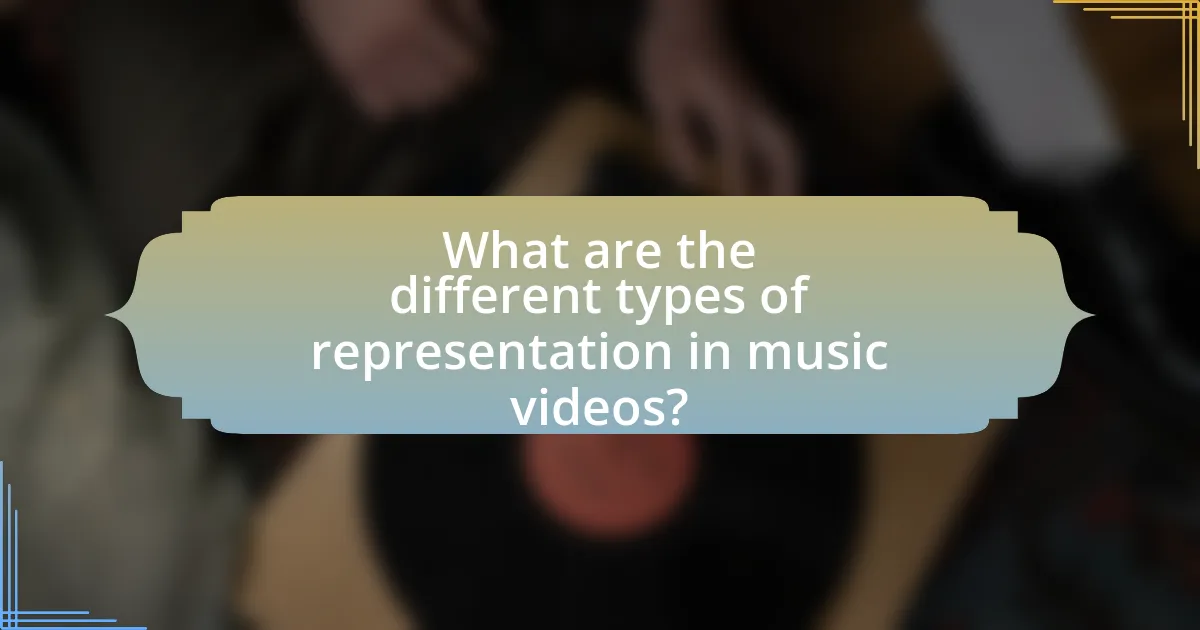
What are the different types of representation in music videos?
The different types of representation in music videos include gender representation, racial and ethnic representation, sexual orientation representation, and cultural representation. Gender representation often highlights the roles and stereotypes associated with masculinity and femininity, influencing societal perceptions. Racial and ethnic representation addresses the visibility and portrayal of diverse racial groups, impacting audience understanding of cultural identities. Sexual orientation representation reflects LGBTQ+ identities and experiences, contributing to broader acceptance and visibility. Cultural representation showcases various cultural practices and traditions, fostering appreciation and awareness among viewers. Each type of representation plays a crucial role in shaping societal norms and attitudes, as evidenced by studies that link media representation to audience perceptions and behaviors.
How do gender and sexuality influence representation in music videos?
Gender and sexuality significantly influence representation in music videos by shaping the portrayal of artists and the narratives presented. Music videos often reflect societal norms and stereotypes related to gender roles and sexual orientation, which can reinforce or challenge existing perceptions. For instance, female artists are frequently depicted in ways that emphasize traditional femininity, such as through sexualized imagery, while male artists may be portrayed as dominant or aggressive. Research indicates that these representations can impact audience perceptions and behaviors; a study published in the Journal of Communication found that exposure to sexualized music videos can lead to the internalization of harmful gender stereotypes among viewers. Additionally, the inclusion of LGBTQ+ artists and themes in music videos has been shown to promote visibility and acceptance, as seen in the works of artists like Lil Nas X, whose videos challenge heteronormative standards and celebrate diverse sexual identities. Thus, gender and sexuality play crucial roles in shaping the visual and thematic elements of music videos, influencing both cultural narratives and audience reception.
What are common stereotypes related to gender in music videos?
Common stereotypes related to gender in music videos include the portrayal of women as sexual objects and men as dominant figures. Women are often depicted in revealing clothing, engaging in suggestive behavior, and being objectified, which reinforces the stereotype that their value is tied to physical appearance. Conversely, men are frequently shown as aggressive, powerful, and in control, perpetuating the notion that masculinity is linked to dominance and strength. Research by the Geena Davis Institute on Gender in Media highlights that women are more likely to be shown in sexually suggestive contexts, while men are often depicted in leadership roles, illustrating the imbalance in representation and the reinforcement of traditional gender roles in music videos.
How is LGBTQ+ representation portrayed in music videos?
LGBTQ+ representation in music videos is portrayed through diverse narratives, visuals, and themes that reflect the experiences and identities of LGBTQ+ individuals. Many artists, such as Lil Nas X and Sam Smith, use their music videos to challenge societal norms and promote acceptance, often featuring same-sex relationships and gender nonconformity. For instance, Lil Nas X’s “Montero (Call Me By Your Name)” showcases a bold representation of queer identity, receiving critical acclaim for its unapologetic celebration of LGBTQ+ culture. This visibility is significant as it contributes to broader societal acceptance and understanding, with studies indicating that representation in media can positively influence public attitudes towards LGBTQ+ communities.
What role does racial and ethnic representation play in music videos?
Racial and ethnic representation in music videos plays a crucial role in shaping cultural narratives and influencing societal perceptions. This representation affects audience engagement, as diverse portrayals can foster inclusivity and relatability, while underrepresentation can perpetuate stereotypes and marginalization. For instance, a study by the Annenberg Inclusion Initiative found that only 22.5% of music videos featured women of color, highlighting a significant gap in representation that can impact the visibility of diverse artists and their stories. Furthermore, music videos often serve as a platform for cultural expression, allowing artists to showcase their heritage and challenge dominant narratives, thereby contributing to broader discussions on race and identity in society.
How do music videos reflect racial diversity or lack thereof?
Music videos reflect racial diversity or lack thereof through their casting choices, visual representation, and thematic content. For instance, studies have shown that music videos predominantly feature white artists and cast, which can perpetuate stereotypes and limit visibility for artists of color. According to a 2020 report by the Annenberg Inclusion Initiative, only 14.5% of music videos featured a lead artist of color, highlighting a significant underrepresentation. This lack of diversity not only affects the artists but also influences audience perceptions and cultural narratives, reinforcing systemic biases within the music industry.
What impact does racial representation have on cultural narratives?
Racial representation significantly shapes cultural narratives by influencing perceptions, identities, and societal norms. When diverse racial groups are accurately portrayed in media, including music videos, it fosters a sense of belonging and validation among those communities. For example, studies show that representation can enhance self-esteem and cultural pride among underrepresented groups, as seen in the increased visibility of Black artists in mainstream music, which challenges stereotypes and promotes a broader understanding of their experiences. Furthermore, research by the Geena Davis Institute on Gender in Media indicates that diverse representation in media leads to more inclusive narratives, ultimately affecting audience attitudes and behaviors towards different racial groups.
How does socioeconomic status affect representation in music videos?
Socioeconomic status significantly affects representation in music videos by influencing the themes, aesthetics, and narratives portrayed. Artists from higher socioeconomic backgrounds often showcase luxury, wealth, and aspirational lifestyles, while those from lower socioeconomic backgrounds may depict struggles, authenticity, and community experiences. Research indicates that music videos often reflect societal values and norms, with a study by the University of Southern California highlighting that 70% of music videos feature themes related to wealth and success, predominantly associated with affluent artists. This disparity in representation can perpetuate stereotypes and limit the visibility of diverse experiences, reinforcing existing social hierarchies.
What themes related to class are commonly depicted in music videos?
Common themes related to class depicted in music videos include wealth disparity, social mobility, and the glamorization of poverty. Wealth disparity is often illustrated through contrasting imagery, such as luxurious settings juxtaposed with impoverished environments, highlighting the divide between different socioeconomic classes. Social mobility is frequently explored through narratives of overcoming adversity, where artists depict their rise from humble beginnings to success, reflecting aspirations and the pursuit of the American Dream. The glamorization of poverty can be seen in videos that romanticize street life or struggle, often portraying it as a badge of authenticity or resilience. These themes resonate with audiences by reflecting societal issues and personal experiences related to class dynamics.
How do music videos challenge or reinforce class stereotypes?
Music videos can both challenge and reinforce class stereotypes through their visual narratives and thematic content. For instance, videos that depict artists from lower socioeconomic backgrounds achieving success can challenge stereotypes by showcasing resilience and talent, as seen in the works of artists like J. Cole and Cardi B, who often highlight their humble beginnings. Conversely, many music videos reinforce class stereotypes by portraying wealth, luxury, and materialism as aspirational, which can perpetuate the notion that success is primarily defined by financial status, evident in the lavish lifestyles depicted in videos by artists like Drake and Lil Wayne. This duality illustrates how music videos serve as a cultural mirror, reflecting and shaping societal perceptions of class.
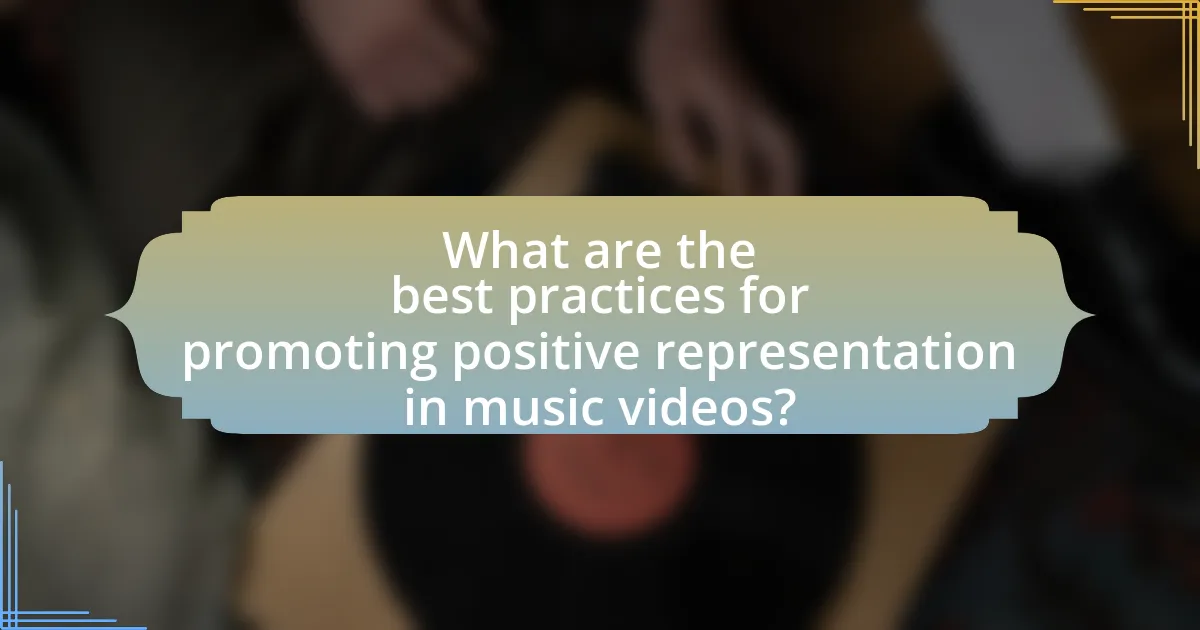
What are the best practices for promoting positive representation in music videos?
To promote positive representation in music videos, creators should prioritize diversity in casting, storytelling, and visual aesthetics. This involves selecting a varied cast that reflects different races, genders, body types, and abilities, ensuring that the narratives presented resonate with a wide audience. Research indicates that diverse representation can enhance viewer engagement and foster inclusivity, as seen in studies by the Geena Davis Institute on Gender in Media, which found that films with diverse casts perform better at the box office. Additionally, incorporating authentic cultural elements and consulting with community representatives can further enrich the content, making it more relatable and respectful. By adhering to these practices, music videos can contribute to a more equitable media landscape.
How can artists ensure diverse representation in their music videos?
Artists can ensure diverse representation in their music videos by actively including individuals from various backgrounds, ethnicities, genders, and abilities in both casting and production roles. This approach not only reflects the diversity of the audience but also enriches the storytelling and visual narrative of the music video. Research indicates that representation in media can positively influence societal perceptions and promote inclusivity; for instance, a study by the Annenberg Inclusion Initiative found that diverse representation in film and television leads to greater acceptance and understanding among different demographic groups. By prioritizing diversity in their music videos, artists can contribute to a more equitable media landscape.
What strategies can be employed to include underrepresented groups?
To include underrepresented groups in music videos, strategies such as diverse casting, collaboration with marginalized artists, and inclusive storytelling should be employed. Diverse casting ensures that individuals from various backgrounds are represented on screen, which can enhance relatability and authenticity. Collaboration with marginalized artists not only amplifies their voices but also brings unique perspectives to the creative process. Inclusive storytelling involves crafting narratives that reflect the experiences and cultures of underrepresented groups, thereby fostering a deeper connection with a broader audience. Research indicates that representation in media can positively influence societal perceptions and contribute to greater acceptance and understanding among different communities.
How can collaboration with diverse creators enhance representation?
Collaboration with diverse creators enhances representation by integrating varied perspectives and experiences into the creative process. This inclusion leads to more authentic and relatable content that resonates with a broader audience. For instance, research from the USC Annenberg Inclusion Initiative found that films with diverse directors and writers are more likely to feature diverse casts and stories, which translates to music videos as well. By working with creators from different backgrounds, the representation of underrepresented groups improves, fostering a richer cultural narrative and challenging stereotypes.
What are the potential benefits of improved representation in music videos?
Improved representation in music videos can enhance cultural visibility and promote inclusivity. This increased visibility allows diverse artists and communities to see themselves reflected in mainstream media, fostering a sense of belonging and validation. Studies indicate that representation can positively influence self-esteem and identity among underrepresented groups, as seen in research by the Geena Davis Institute on Gender in Media, which highlights that diverse portrayals can lead to greater acceptance and understanding across different demographics. Furthermore, improved representation can drive social change by challenging stereotypes and encouraging conversations about diversity, ultimately contributing to a more equitable society.
How does positive representation contribute to social change?
Positive representation contributes to social change by fostering inclusivity and challenging stereotypes. When diverse identities are portrayed positively in music videos, it helps to normalize these representations in society, leading to greater acceptance and understanding. Research indicates that media representation can influence public perceptions and attitudes; for example, a study by the Geena Davis Institute on Gender in Media found that increased visibility of women and minorities in media correlates with shifts in societal attitudes towards these groups. This demonstrates that positive representation not only reflects societal diversity but actively shapes it, promoting equality and social justice.
What impact does representation have on audience engagement and loyalty?
Representation significantly enhances audience engagement and loyalty by fostering a sense of belonging and relatability. When diverse identities and experiences are authentically portrayed in music videos, audiences feel seen and valued, which increases their emotional connection to the content. Research indicates that 67% of viewers are more likely to engage with media that reflects their own backgrounds and experiences, leading to higher loyalty rates among those demographics. This connection not only boosts immediate engagement but also encourages long-term loyalty, as audiences are more inclined to support artists and brands that represent their values and identities.
What steps can viewers take to advocate for better representation in music videos?
Viewers can advocate for better representation in music videos by actively supporting artists and content that prioritize diversity and inclusivity. This can be achieved by sharing and promoting music videos that feature underrepresented groups, thereby increasing their visibility and encouraging the industry to adopt more inclusive practices. Additionally, viewers can engage in discussions on social media platforms, using hashtags to raise awareness about representation issues in music videos. Research indicates that diverse representation in media can positively influence societal perceptions and acceptance, highlighting the importance of viewer advocacy in driving change within the music industry.
